Predicting the Potential Distribution of Hypericum perforatum under Climate Change Scenarios Using a Maximum Entropy Model
Abstract
:Simple Summary
Abstract
1. Introduction
2. Materials and Methods
2.1. Species Distribution Data
2.2. Bioclimatic Data Acquisition and Screen
2.3. Settings of the MaxEnt Model
2.4. Model Precision Test and Suitability Level Classification
2.5. Analysis of Centroid Migration in Suitable Distribution Areas
3. Results
3.1. Accuracy of Model Analysis
3.2. Dominant Environmental Factors
3.3. Ecological Niche Modeling
3.3.1. Suitable Areas under Past Climate Conditions
3.3.2. Current Potential Distribution Estimates
3.3.3. Suitable Distribution under Future Climate Scenarios
3.4. Spatial Pattern Changes under Future Climate Conditions
3.5. The Migration Trends of the Geometric Center of Suitable Habitat
4. Discussion
4.1. Rationality of Model
4.2. Climate Effects
4.3. Change in Geographic Distributions
5. Conclusions
Supplementary Materials
Author Contributions
Funding
Institutional Review Board Statement
Informed Consent Statement
Data Availability Statement
Conflicts of Interest
References
- Han:, Y.; Feng, W.Q.; Zhang, T.T.; Wen, J.W.; Liu, L.Q.; He, Y. Influence of ecological factors on the distribution of medicinal plant resources. Chin. J. Tradit. Chin. Med. 2023, 38, 1450–1453. [Google Scholar]
- Zuo, Y.F.; He, Y.F.; Wang, L. Geographic distribution patterns of mochella species in response to climate change in East Asia. J. Appl. Ecol. 2023, 34, 777–786. [Google Scholar]
- Wei, B.; Wang, R.; Hou, K. Predicting the current and future cultivation regions of Carthamus tinctorius using MaxEnt model under climate change in China. Glob. Ecol. Conserv. 2018, 16, 477. [Google Scholar] [CrossRef]
- Hending, D.; Holderied, M.; McCabe, G. Effects of future climate change on the forests of Madagascar. Ecosphere 2022, 13, 4017. [Google Scholar] [CrossRef]
- Masson-Delmotte, V.; Zhai, P.; Pirani, A. Climate change 2021: The physical science basis. In Contribution of Working Group I to the Sixth Assessment Report of the Intergovernmental Panel on Climate Change; IPCC: Geneva, Switzerland, 2021; Volume 2, p. 2391. [Google Scholar]
- Niu, S.L.; Chen, W.N. Current Status and Prospects of Global Change and Ecosystem Research. Acta Phytoecol. Sin. 2020, 44, 449–460. [Google Scholar]
- Gao, J.B.; Jiao, K.W.; Wu, S.H.; Guo, L.H. Theoretical Paradigms and Methodological Systems for Research on the Impact and Risk of Climate Change. Acta Ecol. Sin. 2017, 37, 2169–2178. [Google Scholar]
- Jiao, K.W.; Gao, J.B.; Wu, S.H.; Hou, W.J. Research Progress on the Response Process of Vegetation Activities to Climate Change. Acta Ecol. Sin. 2018, 38, 2229–2238. [Google Scholar]
- Pyšek, P.; Hulme, P.E.; Simberloff, D.; Bacher, S.; Blackburn, T.M.; Carlton, J.T.; Dawson, W.; Essl, F.; Foxcroft, L.C.; Genovesi, P.; et al. Scientists’ warning on invasive alien species. Biol. Rev. 2020, 95, 1511–1534. [Google Scholar] [CrossRef]
- Xu, W.M.; Wu, F.Y.; Wang, H.J.; Zhao, L.Y.; Liu, X.; Xiang, P.; Guan, H.L. Key soil parameters afecting the survival of Panax notoginseng under continuous cropping. Sci. Rep. 2021, 1, 5656. [Google Scholar] [CrossRef]
- Wang, W.T.; Gao, S.Y.; Wang, S.F. Study on the Prediction of Potential Invasive Areas of Four Toxic Weeds in Grasslands in Gansu Province. Acta Ecol. Sin. 2019, 39, 5301–5307. [Google Scholar]
- Liu, X.D.; Yang, Q.H.; Fu, C.L. Prediction of Potential Suitable Habitat for Microtome Cherry Based on MaxEnt Model under Future Climate Scenarios. Jiangsu For. Sci. Technol. 2022, 49, 11–16. [Google Scholar]
- Guo, Y.L.; Zhao, Z.F.; Qiao, H.J.; Wang, R.; Wei, H.Y.; Wang, L.K.; Gu, W.; Li, X. Challenges and Development Trends of Species Distribution Models. Adv. Earth Sci. 2020, 35, 1292–1305. [Google Scholar]
- Silva, L.D.; Elias, R.B.; Silva, L. Modelling invasive alien plant distribution: A literature review of concepts and bibliometric analysis. Environ. Model. Softw. 2021, 145, 105–203. [Google Scholar]
- Xie, W.D.; Jia, J.; Bu, C.L.; Ma, L.M.; Guo, J.G.; Song, K.; Li, H.X.; Sun, Y.H.; Fang, Y. Habitat Assessment of Nationally Protected Birds in the Yanshan Area and Analysis of Protection Gaps in National Nature Reserves. Zool. Res. 2022, 57, 170–184. [Google Scholar]
- Pan, S.Y.; Zhu, Z.H.; Yao, T.H.; Wang, Y.X.; Zhou, P. Predicting the Suitable Distribution of the Medicinal Plant Pleuropterus multiflorus in China under the Background of Climate Change. J. Northwest AF Univ. (Nat. Sci. Ed.) 2016, 44, 192–198. [Google Scholar]
- Zhang, L.M.; Pang, L.F.; Xu, D.P.; Tang, X.M. Prediction of potential distribution of Pinus koraiensis in Northeast China based on MaxEnt model. J. Jiangxi Agric. Univ. 2020, 42, 74–83. [Google Scholar]
- Yao, Y.Y.; Lü, M.; Liu, X.Z.; Li, J.; Cao, X.L.; Zhang, C.J.; Zhang, Z.; Kang, T.L.; Li, M.F. Establishment of a Rapid Propagation System for the Antidepressant Chinese Herbal Medicine Forsythia suspensa through Tissue Culture. J. Gansu Agric. Univ. 2019, 54, 69–74. [Google Scholar]
- Institute of Botany, Chinese Academy of Sciences (Ed.) Flora of China, Volume 2; Science Press: Beijing, China, 1990; pp. 1–72. [Google Scholar]
- Linde, K.; Ramirez, H.; Mulrow, C.D.; Pauls, A.; Weidenhammer, W.; Melchart, D. St. John’s wort for depression: An overview andmeta-analysis of randomised clinical trials. Br. Med. J. 1996, 313, 253–258. [Google Scholar] [CrossRef]
- Evstifeeva, V.A.; Sibiryak, S.V. The immunotropic properties of biologically active products obtained from Klamath weed (Hypericum perforatum L.). Eksp. Klin. Farmakol. 1996, 59, 51–54. [Google Scholar]
- Thomas, C.; Macgill, R.S.; Miller, G.C.; Pardini, R.S. Photoactivation of hypericin generates singleoxygen in mitochondria and inhibits succinoxidase. Photochem. Photobiol. 1992, 55, 47–53. [Google Scholar] [CrossRef]
- Institute of Botany, Chinese Academy of Sciences. An Illustrated Handbook of Higher Plants of China; Science Press: Beijing, China, 1972; p. 879. [Google Scholar]
- National Pharmacopoeia Committee. Pharmacopoeia of the People’s Republic of China (Volume I); China Medical Science and Technology: Beijing, China, 2020; pp. 242–243. [Google Scholar]
- Shakya, P.; Marslin, G.; Siram, K.; Beerhues, L.; Franklin, G. Elicitation as a tool to improve the profiles of high-value secondary metabolites and pharmacological properties of Hypericum perforatum. J. Pharm. Pharmacol. 2017, 71, 70–82. [Google Scholar] [CrossRef]
- Napoli, E.; Siracusa, L.; Ruberto, G.; Carrubba, A.; Lazzara, S.; Speciale, A.; Cimino, F.; Saija, A.; Cristani, M. Phytochemical profiles, phototoxic and antioxidant properties of eleven Hypericum species– A comparative study. Phytochemistry 2018, 152, 162–173. [Google Scholar] [CrossRef]
- Sheng, K.X.; Wang, H.R.; Xu, L.C.; Han, T. Recent Advances in Pharmacological Actions and Mechanisms of Hypericum perforatum. Chin. J. Pharmacol. Clin. Med. 2023, 39, 117–122. [Google Scholar]
- Radulovic, N.S.; Gencic, M.S.; Stojanovic, N.M.; Randjelovic, P.J.; Baldovini, N.; Kurteva, V. Prenylated β-diketones, two new additions to the family of biologically active Hypericum perforatum (Hypericaceae) secondary metabolites. Food Chem. Toxicol. 2018, 118, 505–513. [Google Scholar] [CrossRef]
- Tang, F.; Tian, Y.X.; Li, X.; Ren, X.Y.; Liu, H.Y. Study on the Mechanism of Anti-depression Active Ingredients of Hypericum perforatum L. Based on Network Pharmacology. Lishizhen Med. Mater. Med. Res. 2019, 30, 1844–1847. [Google Scholar]
- Wood, S.; Huffman, J.; Weber, N. Antiviral activity of naturally occurring anthraquinones and anthraquinone derivatives. Planta Med. 1990, 56, 651–652. [Google Scholar] [CrossRef]
- Murch, S.J.; Choffe, K.L.; Victor, J.M.R.; Slimmon, T.Y.; KrishnaRaj, S.; Saxena, P.K. Thidiazuron-induced plantregeneration, hypocotyls cultures of St, John’s wort (Hypericum perforatum cv*Anthos’). Plant Cell Rep. 2000, 19, 576–581. [Google Scholar] [CrossRef]
- Liang, W.W. Predicting the potential invasion of kudzu bug, Megacoptacribraria (Heteroptera: Plataspidae), in North and South America and determining its climatic preference. Biol. Invasions 2018, 20, 2899–2913. [Google Scholar] [CrossRef]
- Swets, J.A. Measuring the accuracy of diagnostic systems. Science 1988, 240, 1285–1293. [Google Scholar] [CrossRef]
- Li, W.Q.; Xu, Z.F.; Shi, M.M.; Chen, J.H. Predictive analysis of the potential geographical distribution patterns of Salix tetrasperma under different climate scenarios. Acta Ecol. Sin. 2019, 39, 3224–3234. [Google Scholar]
- Phillips, S.J.; Anderson, R.P.; Schapire, R.E. Maximum entropy modeling of species geographic distributions. Ecol. Model. 2006, 190, 231–259. [Google Scholar] [CrossRef]
- Roger, E.; Duursma, D.E.; Downey, P.O.; Gallagher, R.V.; Hughes, L.; Steel, J.; Johnson, S.B.; Leishman, M.R. A tool to assess potential for alien plant establishment and expansion under climate change. J. Environ. Manag. 2015, 159, 121–127. [Google Scholar] [CrossRef]
- Wu, Y.; Wang, H.; Fang, M.F.; Yue, M.; Li, Y.F.; Li, S. Research progress on the influence of environmental factors on the formation of medicinal materials in medicinal plants. Nat. Prod. Res. Dev. 2013, 25, 416–420+429. [Google Scholar]
- Gan, G.J. Cultivation techniques of Forsythia suspensa. Rural. 100 Things 2013, 17, 38–39. [Google Scholar]
- Kang, Z.H. Predicting the potential geographic distribution of Lantana camara in China based on Maxent ecological niche model. Shanxi Agric. Econ. 2021, 09, 121–123. [Google Scholar]
- Sayit, H.; Nurbay, A.; Arman, J. Impact of human activities on potential distribution of Solanum rostratum in Xinjiang. Acta Ecol. Sin. 2019, 39, 629–636. [Google Scholar]
- Thomas, C.D.; Cameron, A.; Green, R.E.; Bakkenes, M.; Beaumont, L.J.; Collingham, Y.C.; Erasmus, B.N.F.; Siqueura, M.F.D.; Williams, S.E. Extinction risk from climate change. Nature 2004, 427, 145–148. [Google Scholar] [CrossRef]
- Leng, W.; He, S.H.; Bu, R. Predicting the distributions of suitable habitat for three larch species under climate warming in Northeastern China. For. Ecol. Manag. 2007, 254, 420–428. [Google Scholar] [CrossRef]
- Chen, I.C.; Hill, J.K.; Ohlemuller, R.; Roy, D.B.; Thomas, C.D. Rapid range shifts of species associated with high levels of climate warming. Science 2011, 333, 1024–1026. [Google Scholar] [CrossRef]

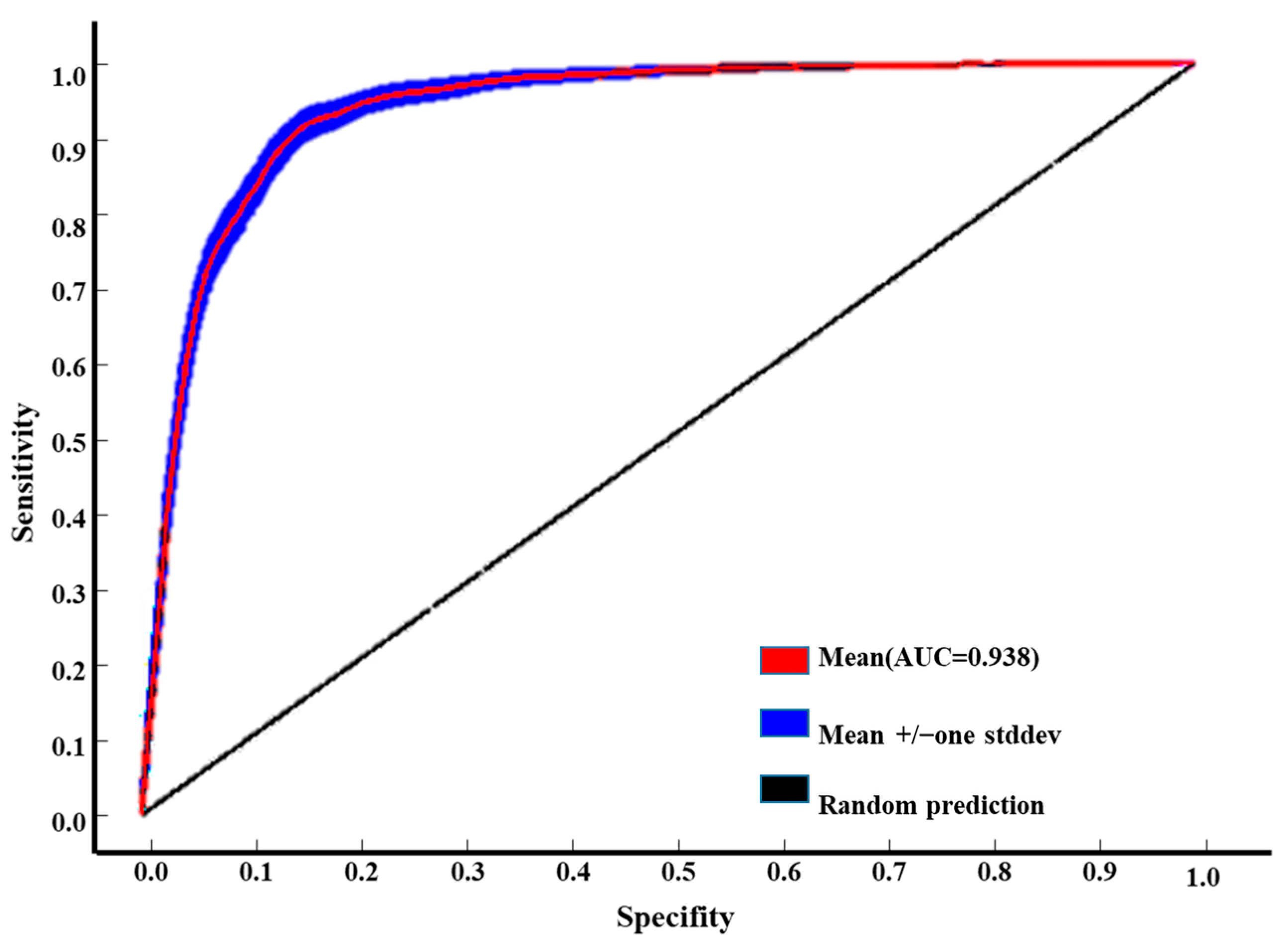
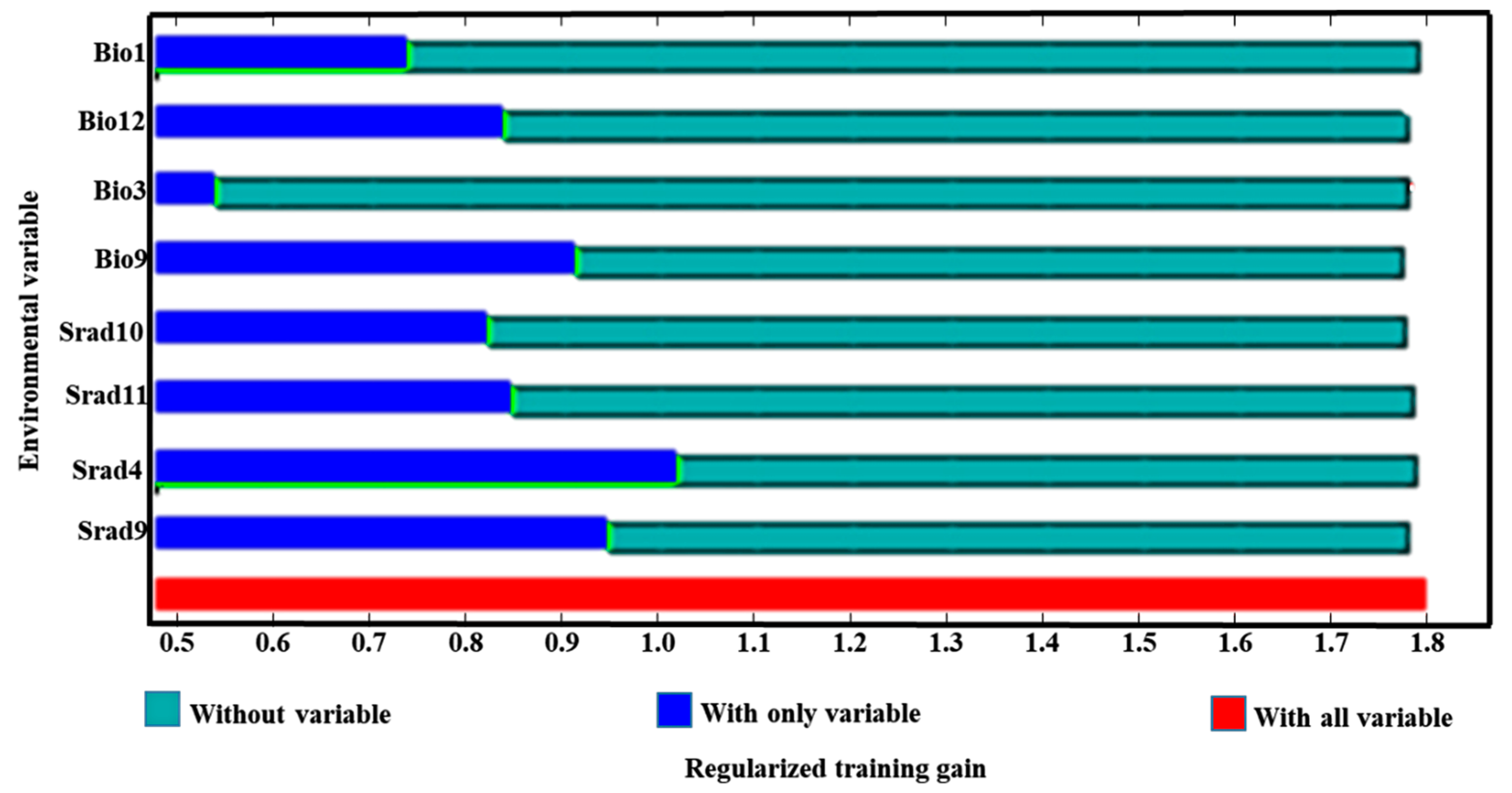
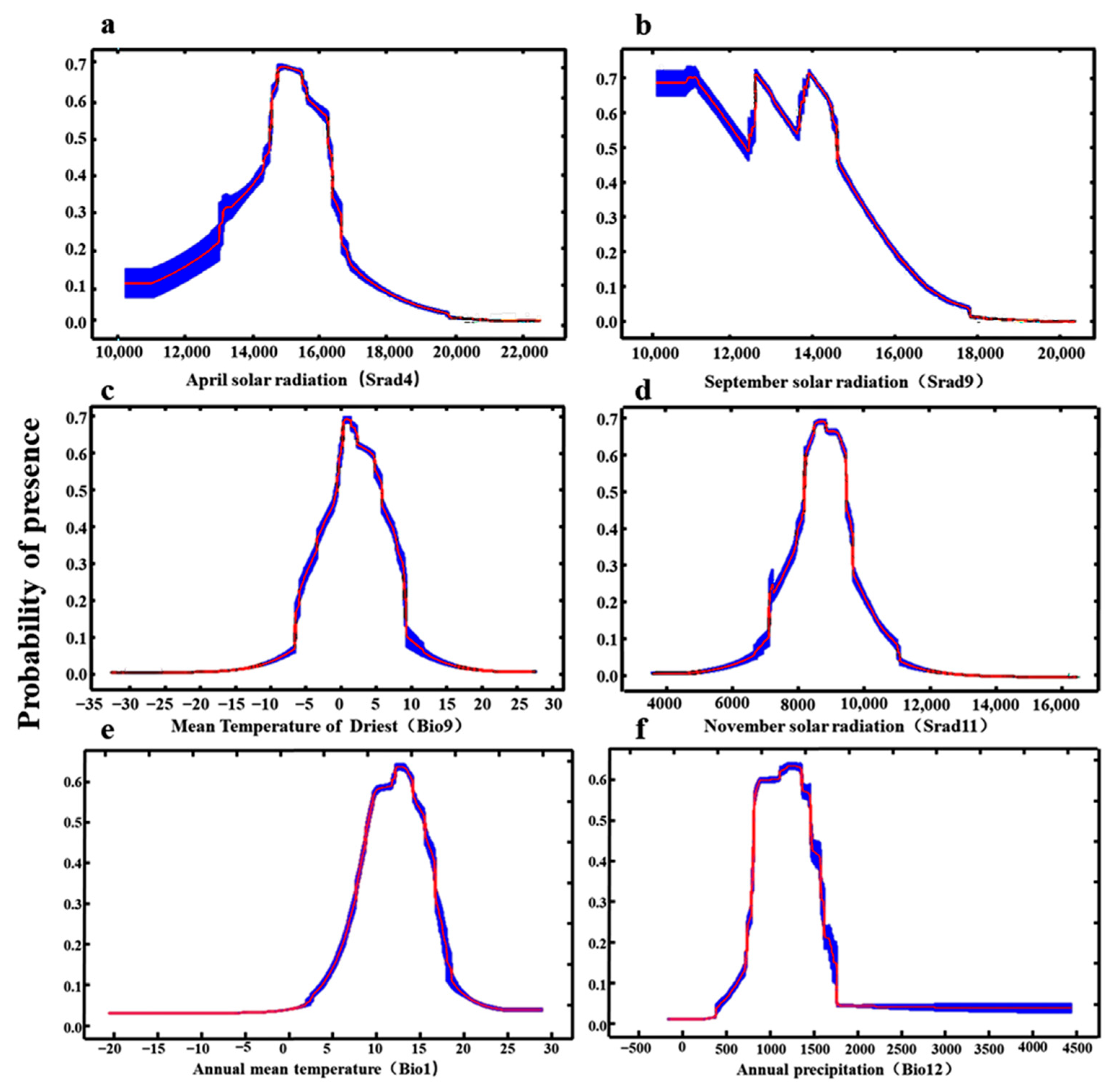
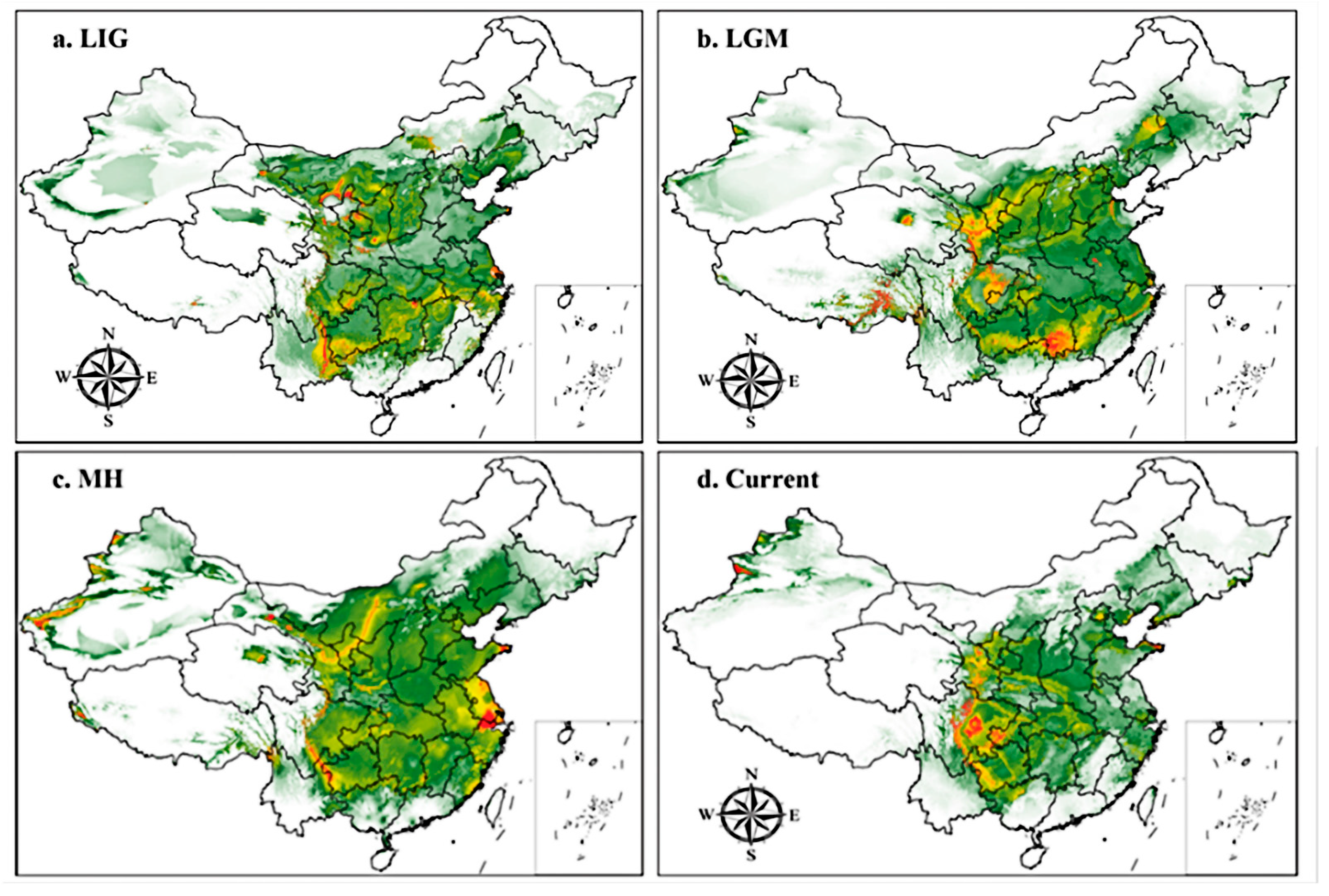
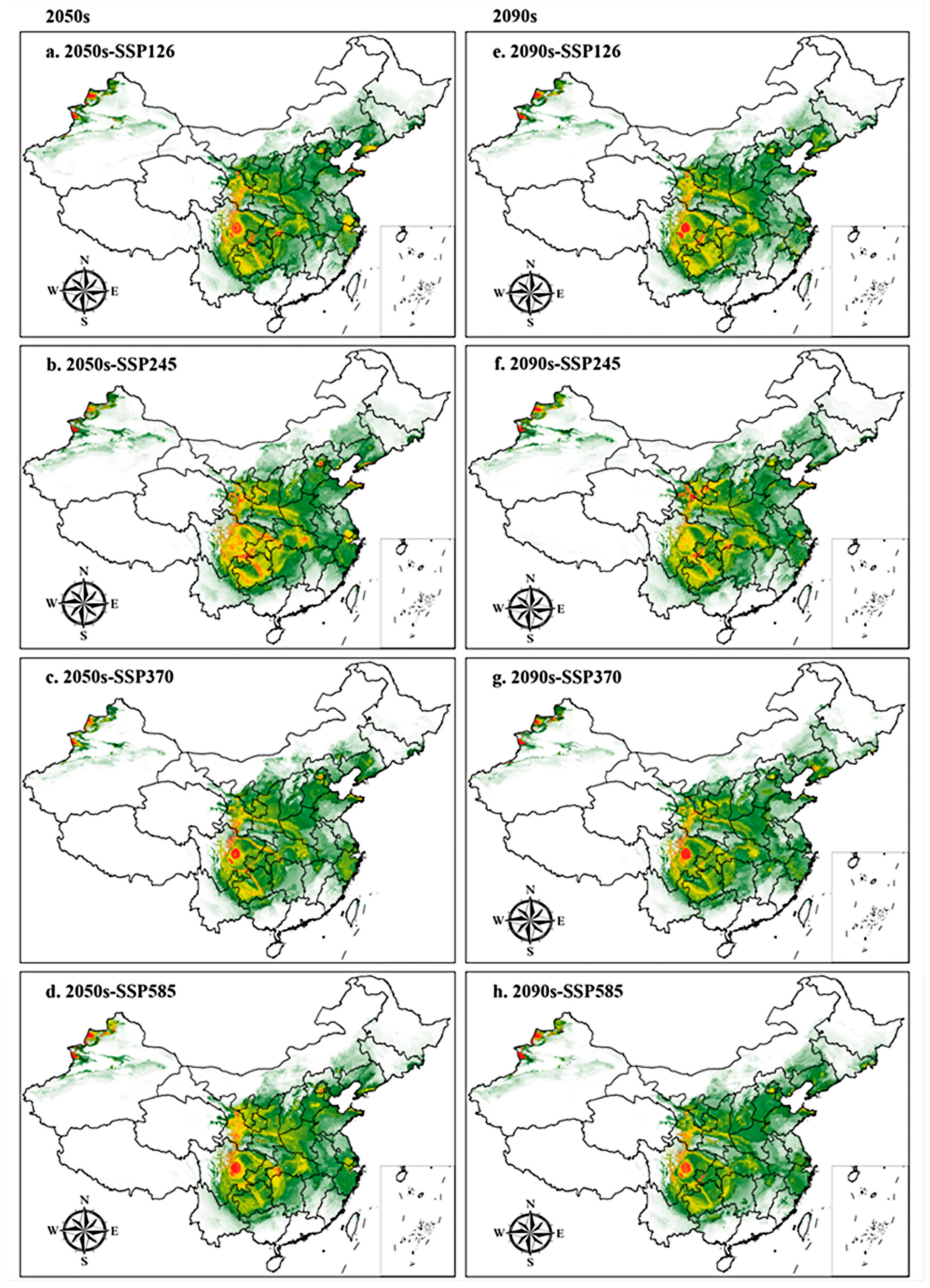
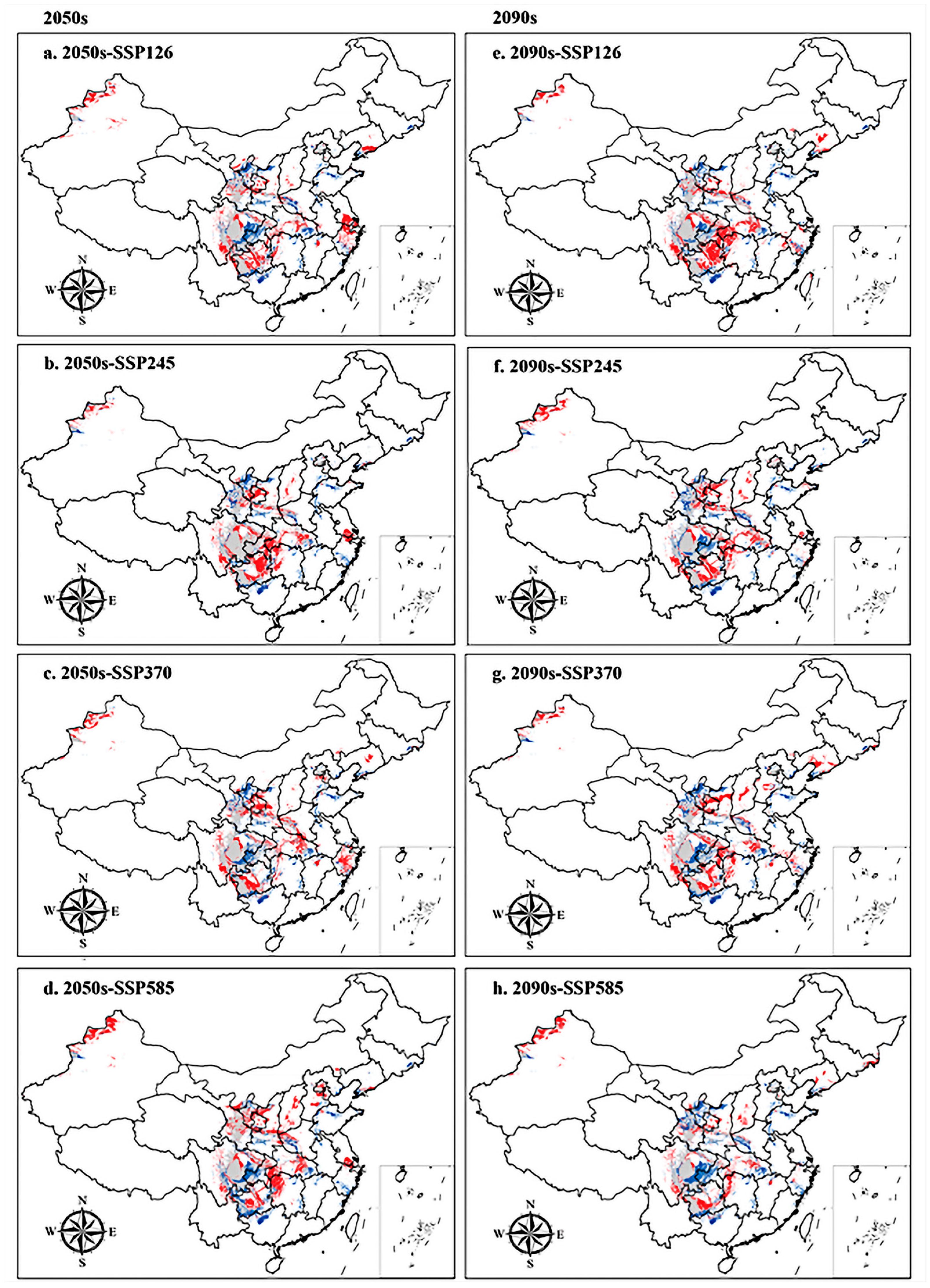

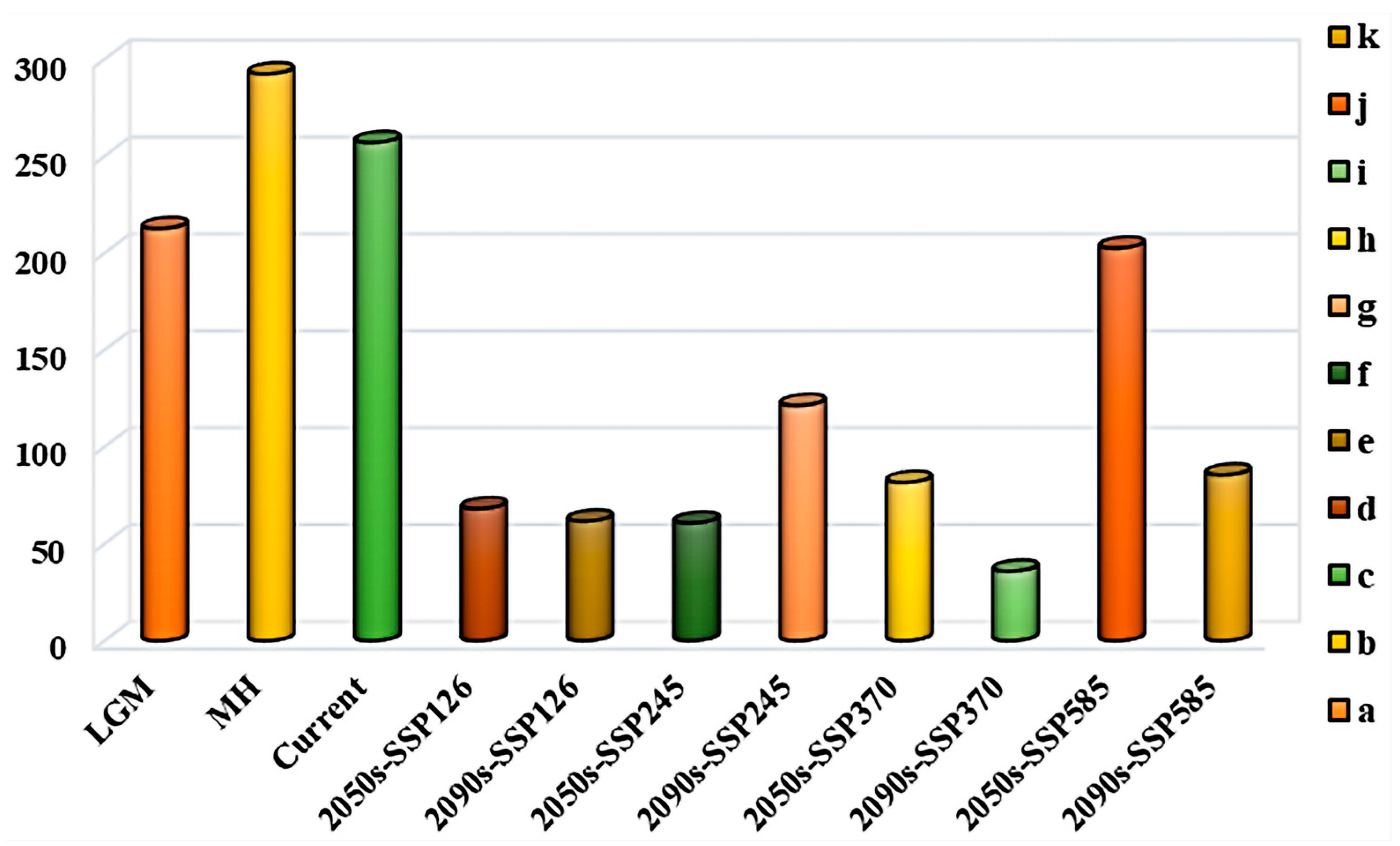
| Num. | Variable | Percent Contribution (%) | Permutation Importance (%) |
|---|---|---|---|
| 1 | April solar radiation (Srad4) | 22.50 | 1.80 |
| 2 | September solar radiation (Srad9) | 21.60 | 13.70 |
| 3 | Mean temperature of driest quarter (Bio9) | 18.50 | 43.70 |
| 4 | Solar radiation in November (Srad11) | 13.20 | 10.40 |
| 5 | October solar radiation (Srad10) | 9.70 | 5.60 |
| 6 | Annual mean temperature (Bio1) | 7.00 | 9.80 |
| 7 | Isothermality (Bio3) | 5.60 | 4.70 |
| 8 | Annual precipitation (Bio12) | 2.00 | 10.20 |
| Period | Regional Information | ||
|---|---|---|---|
| High Suitable Areas | Medium Suitable Areas | Low Suitable Areas | |
| LIG | Yinchuan City, Ningxia Hui Autonomous Prefecture | Ji’an City, Jiangxi Province | Shaanxi, Shanxi, Liaoning, Henan, Hubei, Anhui |
| LGM | Yongzhou City, Hengyang City, Hunan Province | Wuzhong City, Ningxia Hui Autonomous Prefecture | Shanxi, Hebei, Henan, Hubei, Anhui, Jiangsu |
| MH | Suzhou City, Jiangsu Province, Huzhou City, Jiaxing City, Zhejiang Province | Xuzhou City, Suqian City, Huai’an City, Yangzhou City, Jiangsu Province | Shanxi, Hebei, Henan, Hubei, Anhui |
| Current | Chengdu City, Deyang City, Mianyang City, Sichuan Province Yubei District, Hechuan City, Tongnan City, Chongqing City | Longnan City, Tianshui City, Wudu City, Luizhou Province; Bijie City, Liupanshui City, Guizhou Province; Tacheng District, Xinjiang Uygur Autonomous Region | Shaanxi, Henan, Hubei, Zhejiang, Anhui |
| Period | Area of Each Suitable Habitat (×104 km2) | ||||
|---|---|---|---|---|---|
| Non Suitable Areas | Low Suitable Areas | Medium Suitable Areas | High Suitable Areas | Total Suitable Areas | |
| LIG | 650.82 (−121.07) | 111.53 (+13.02) | 92.84 (+34.86) | 104.82 (+73.20) | 309.18 (+121.07) |
| LGM | 714.91 (−56.89) | 67.67 (−30.84) | 108.13 (+50.15) | 69.3 (+37.68) | 245.09 (+56.98) |
| MH | 766.05 (−5.84) | 97.83 (−0.68) | 62.74 (+4.76) | 33.38 (+1.76) | 193.95 (+5.84) |
| Current | 771.89 (0.00) | 98.51 (0.00) | 57.98 (0.00) | 31.62 (0.00) | 188.11 (0.00) |
| Climate Scenarios | Regional Information | ||
|---|---|---|---|
| High Suitable Areas | Medium Suitable Areas | Low Suitable Areas | |
| SSP126 | Chengdu City, Meishan City, Leshan City, Ya’an City, Sichuan Province; Tacheng District, Yili District, Xinjiang | Liupanshui City, Guizhou Province | Shaanxi, Shanxi, Henan, Hunan |
| SSP245 | Pingliang City, Tianshui City, Gansu Province | Chengdu City, Ya’an City, Meishan City, Leshan City, Sichuan Province | Hebei, Henan, Shandong, Zhejiang |
| SSP370 | Chengdu City, Meishan City, Leshan City, Ya’an City, Sichuan Province; Tacheng District, Yili District, Xinjiang | Liupanshui City, Guizhou Province | Hebei, Henan, Shandong, Zhejiang |
| SSP585 | Chengdu City, Meishan City, Leshan City, Ya’an City, Sichuan Province; Tacheng District, Yili District, Xinjiang | Tianshui City, Longnan City, Gansu Province | Henan, Shandong, Anhui, Zhejiang |
| Period | Area of Each Suitable Habitat (×104 km2) | ||||
|---|---|---|---|---|---|
| Non Suitable Areas | Low Suitable Areas | Medium Suitable Areas | High Suitable Areas | Total Suitable Areas | |
| Current | 771.89 (0.00) | 98.51 (0.00) | 57.98 (0.00) | 31.62 (0.00) | 188.11 (0.00) |
| 2050s-SSP126 | 755.81 (−16.08) | 115.34 (+16.83) | 57.01 (−0.97) | 31.84 (+0.22) | 204.19 (+16.08) |
| 2050s-SSP245 | 655.08 (−116.81) | 167.44 (+68.93) | 100.61 (+42.63) | 36.86 (+5.24) | 304.91 (+116.80) |
| 2050s-SSP370 | 758.56 (−13.33) | 114.4 (+15.89) | 55.24 (−2.74) | 31.80 (+0.18) | 201.44 (+13.33) |
| 2050s-SSP585 | 759.67 (−12.22) | 111.53 (+13.02) | 56.97 (−1.01) | 31.83 (+0.21) | 200.33 (+12.22) |
| 2090s-SSP126 | 763.66 (−8.23) | 108.25 (+9.74) | 56.45 (−1.53) | 31.65 (+0.03) | 196.34 (+8.23) |
| 2090s-SSP245 | 628.83 (−143.06) | 174.28 (+58.40) | 61.84 (+6.11) | 33.61 (+1.99) | 223.38 (+35.27) |
| 2090s-SSP370 | 754.29 (−17.60) | 117.37 (+18.86) | 53.88 (−4.1) | 34.46 (+2.84) | 205.71 (+17.6) |
| 2090s-SSP585 | 757.94 (−13.95) | 116.69 (+18.8) | 53.44 (−4.54) | 31.94 (+0.32) | 202.06 (+13.95) |
| Period | Area (×104 km2) | |||
|---|---|---|---|---|
| Expansion Zone | Reserve Zone | Shrinkage Zone | Changes | |
| 2050s-SSP126 | 25.91 | 33.25 | 22.33 | 3.58 |
| 2050s-SSP245 | 27.33 | 37.76 | 17.81 | 9.52 |
| 2050s-SSP370 | 26.38 | 35.04 | 20.37 | 6.01 |
| 2050s-SSP585 | 31.06 | 33.15 | 22.42 | 8.64 |
| 2090s-SSP126 | 29.78 | 36.26 | 19.31 | 10.47 |
| 2090s-SSP245 | 26.44 | 33.01 | 22.57 | 3.87 |
| 2090s-SSP370 | 26.59 | 32.68 | 22.89 | 3.70 |
| 2090s-SSP585 | 18.48 | 30.50 | 25.08 | −6.60 |
Disclaimer/Publisher’s Note: The statements, opinions and data contained in all publications are solely those of the individual author(s) and contributor(s) and not of MDPI and/or the editor(s). MDPI and/or the editor(s) disclaim responsibility for any injury to people or property resulting from any ideas, methods, instructions or products referred to in the content. |
© 2024 by the authors. Licensee MDPI, Basel, Switzerland. This article is an open access article distributed under the terms and conditions of the Creative Commons Attribution (CC BY) license (https://creativecommons.org/licenses/by/4.0/).
Share and Cite
Hao, Y.; Dong, P.; Wang, L.; Ke, X.; Hao, X.; He, G.; Chen, Y.; Guo, F. Predicting the Potential Distribution of Hypericum perforatum under Climate Change Scenarios Using a Maximum Entropy Model. Biology 2024, 13, 452. https://doi.org/10.3390/biology13060452
Hao Y, Dong P, Wang L, Ke X, Hao X, He G, Chen Y, Guo F. Predicting the Potential Distribution of Hypericum perforatum under Climate Change Scenarios Using a Maximum Entropy Model. Biology. 2024; 13(6):452. https://doi.org/10.3390/biology13060452
Chicago/Turabian StyleHao, Yulan, Pengbin Dong, Liyang Wang, Xiao Ke, Xiaofeng Hao, Gang He, Yuan Chen, and Fengxia Guo. 2024. "Predicting the Potential Distribution of Hypericum perforatum under Climate Change Scenarios Using a Maximum Entropy Model" Biology 13, no. 6: 452. https://doi.org/10.3390/biology13060452





